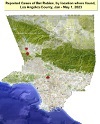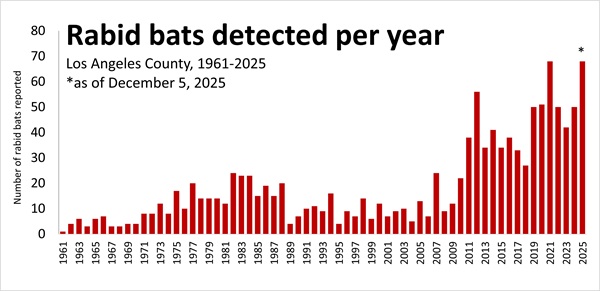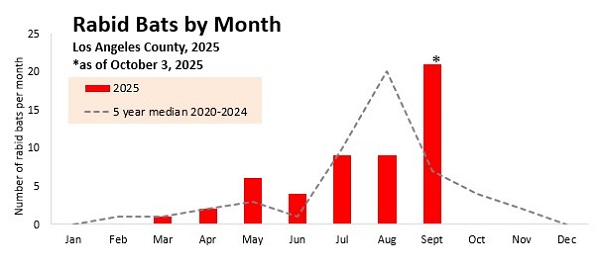Veterinary Public Health Program
313 N Figueroa St. Rm 1127
Los Angeles, CA 90012
Tel (213) 288-7060
Fax (213) 481-2375
vet@ph.lacounty.gov
|

Note: PDF documents on this site were created using Adobe Acrobat
5.0 or later. If you are using an earlier version of Adobe Acrobat
Reader (4.x or less), document functionality may be reduced.
|
|
 |
PROTECT YOURSELF
FROM
RABIES
Report any animal/human contact to
bats, animal bites to humans,
or wildlife bites to pets.
Reporting forms
|
What is rabies?
-
It is a virus that
causes disease in
both people and animals.
Any mammal can get rabies - the list is
long and includes:
-
Bats, dogs, cats,
raccoons, skunks, opossums, coyotes, foxes, cattle, horses, and many more
-
In Los Angeles County,
the only known animals to routinely carry rabies are
BATS
-
In other parts of
California, the
USA and the world, other
animal species can be a
reservoir for rabies
-
Learn more
about past rabies cases in animals in
LA County
-
Learn more about past
rabies cases in humans in
LA County
-
Rabies is usually deadly if medical
attention is not taken rapidly
(post-exposure prophylaxis)
How is rabies transmitted to
people/animals?
What are symptoms of rabies?
-
Rabies affects the nervous system of
infected animals and people
-
The disease is progressive and, once
symptoms start, can rapidly cause death
from respiratory failure
-
In people: initially
fever, weakness, headache; progressing
to tingling sensation, anxiety,
agitation, abnormal behavior,
hallucinations, difficulty
swallowing, coma, death
-
In animals:
initially non-specific signs
(vomiting, respiratory distress)
progressing into neurologic signs -
circling, difficulties walking, behavior
change, aggression, paralysis, hydrophobia (fear of water), death
What is the
treatment for rabies?
-
Once symptoms occur, there is no cure
-
After a bite from a suspected rabid
animals, contact your physician
immediately to receive
Post-Exposure Prophylaxis
(PEP)
-
PEP is a series of
rabies vaccinations
along with an injection
of antibodies - it is
NOT
given in the belly
-
If given as soon as
possible after exposure
to rabies, PEP can
effectively prevent
rabies from entering the
nervous system
-
Pets that have been exposed to rabies
(for example from a bite by a
potentially rabid animal) must be
quarantined whether they are vaccinated
against rabies or not
What should
I do to protect myself from rabies?
-
Never touch a bat with bare hands - call
Animal Control
if you find a bat in your house or on
the ground
-
Seek medical care immediately if you are
bitten by an animal - animal
bites to people are reportable to our
office
-
Keep your pets up to date on their
rabies vaccines
-
This includes older pets
and indoor only cats
(rabid bats have been
found inside homes)
-
If bitten by wildlife,
unvaccinated pets must
be quarantined for 6
months - vaccinated pets
must be quarantined for
30 days only
-
What to do if you find a bat

-
 For quick tips and
additional rabies educational
information that can be shared with
family and friends, click
here.
For quick tips and
additional rabies educational
information that can be shared with
family and friends, click
here.
Rabies data in Los Angeles
County Rabies in bats has increased in the past few
years in Los Angeles County. The reason behind this
increase remains unknown. About 15-20% of bats tested
locally have rabies but less than 1% of healthy bats are
thought to carry rabies.
Rabies Map
- 2025
(click map for larger image)
 |
 |
|
Rabies maps by year:
|
 |
Data based
on passive reporting. Reports of sick bats in public or
private areas, or bat incidents involving people or
animals, are made to local Animal Control agencies. Bats
are then collected and tested for rabies.
Los Angeles
County began testing bats for rabies in 1961. The data
above includes
rabid bats from Pasadena and Long Beach.
More Information
California Department of
Public Health (CDPH) Rabies page
Centers for Disease Control
and Prevention (CDC) Rabies page
Los Angeles County Department
of Public Health - Acute Communicable Disease Control
Rabies page
History of rabies in Los Angeles County
Laws related to rabies

CDC - Podcasts about rabies
Rabies
training for animal shelter/animal care staff in Los
Angeles County
Flyers, posters and brochures
Poster -
Animal Bites and Rabies Risk -
Recommendations for Los Angeles
County
Rabid bat
educational outreach materials
Rabies tales from Los Angeles County
Bats and Rabies (CDC)
Rabies (CDPH)
What to do if you find a bat
(English & Spanish)
What to do if you find a bat (Chinese Simplified)

What to do if you find a bat (Chinese Traditional)

What to do if you find a bat (Armenian)

What to do if you find a bat (Korean)

What to do if you find a bat (Japanese)

Last updated: December 3, 2025
|
|
|